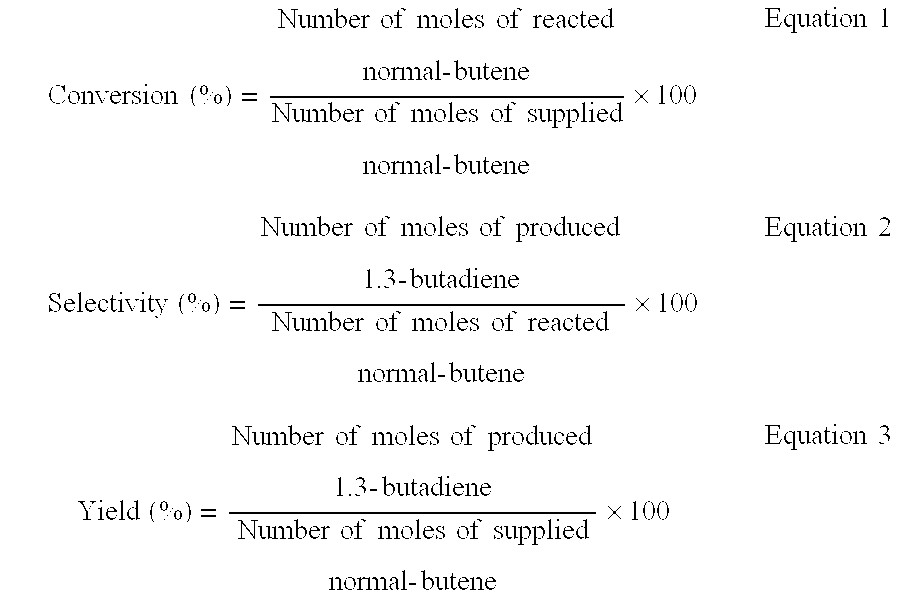Method for preparing 1,3-butadiene as high yield
a technology of 1,3butadiene and high yield, which is applied in the direction of hydrocarbon preparation catalysts, organic chemistry, chemistry apparatus and processes, etc., can solve the problems of not being suitable for a commercial process to produce 1,3-butadiene, requiring production of other feedstocks, and entanglement of the cracking process, so as to achieve good oxidative dehydrogenation activity, good catalytic reactivity, and high selectivity
- Summary
- Abstract
- Description
- Claims
- Application Information
AI Technical Summary
Benefits of technology
Problems solved by technology
Method used
Image
Examples
preparation example 2
Second Catalyst Preparation-1
[0052]Potassium nitrate (KNO3) was used as a potassium precursor, cesium nitrate (CsNO3) was used as a cesium precursor, cobalt nitrate hexahydrate (Co(NO3)2.6H2O) was used as a cobalt precursor, iron nitrate nonahydrate (Fe (NO3)3.9H2O) was used as an iron precursor, bismuth nitrate pentahydrate (Bi(NO3)2.5H2O) was used as a bismuth precursor, and ammonium molybdate tetrahydrate ((NH4) 6Mo7O24.4H2O) was used as a molybdenum precursor. water, but bismuth nitrate pentahydrate was well dissolved in a strong acidic solution. Accordingly, bismuth nitrate pentahydrate was apart dissolved by the addition of nitric acidic solution in distilled water.
[0053]To produce a second catalyst, a molar ratio of molybdenum:bismuth:iron:cobalt:cesium:potassium was set to 12:1:1:7:0.15:0.06.
[0054]105.9 g of bismuth nitrate pentahydrate (Bi(NO3)2.5H2O) was added to a solution of 33.0 g of nitric acid in 28 mL of distilled water, followed by dissolving with stirring. After co...
preparation example 3
Second Catalyst Preparation-2
[0059]Potassium nitrate (KNO3) was used as a potassium precursor, cesium nitrate (CsNO3) was used as a cesium precursor, cobalt nitrate hexahydrate (Co(NO3)2.6H2O) was used as a cobalt precursor, iron nitrate nonahydrate (Fe (NO3)3. 9H2O) was used as an iron precursor, bismuth nitrate pentahydrate (Bi(NO3)2.5H2O) was used as a bismuth precursor, and ammonium molybdate tetrahydrate ((NH4)6Mo7O24.4H2O) was used as a molybdenum precursor.
[0060]To produce a second catalyst, a molar ratio of molybdenum:bismuth:iron:cobalt:cesium:potassium was set at 12:1:1:7:0.07:0.06.
[0061]105.9 g of bismuth nitrate pentahydrate (Bi(NO3)2.5H2O) was added to acid in 28 mL of distilled water added 33.0 g of nitric acid, followed by dissolving with stirring. After confirming that the bismuth has completely dissolved, a solution containing 3.0 g of cesium nitrate hydrate (CsNO3) as the cesium precursor, 1.3 g of potassium nitrate (KNO3) as the potassium precursor, 449.3 g of cob...
preparation example 4
Second Catalyst Preparation-3
[0066]Potassium nitrate (KNO3) was used as a potassium precursor, cesium nitrate (CsNO3) was used as a cesium precursor, cobalt nitrate hexahydrate (Co(NO3)2.6H2O) was used as a cobalt precursor, iron nitrate nonahydrate (Fe (NO3)3.9H2O) was used as an iron precursor, bismuth nitrate pentahydrate (Bi(NO3)2.5H2O) was used as a bismuth precursor, and ammonium molybdate tetrahydrate ((NH4)6Mo7O24.4H2O) was used as a molybdenum precursor.
[0067]In order to produce a second catalyst, a molar ratio of molybdenum:bismuth:iron:cobalt:cesium:potassium was set at 12:1:1:7:0.03:0.06.
[0068]105.9 g of bismuth nitrate pentahydrate (Bi(NO3)2.5H2O) was added to 28 mL of distilled water added 33.0 g of a nitric acid, followed by dissolving with stirring. After confirming that the bismuth has completely dissolved, a solution containing 1.3 g of cesium nitrate hydrate (CsNO3) as the cesium precursor, 1.3 g of potassium nitrate (KNO3) as the potassium precursor, 449.3 g of c...
PUM
| Property | Measurement | Unit |
|---|---|---|
| temperature | aaaaa | aaaaa |
| weight ratio | aaaaa | aaaaa |
| weight ratio | aaaaa | aaaaa |
Abstract
Description
Claims
Application Information
 Login to View More
Login to View More - R&D
- Intellectual Property
- Life Sciences
- Materials
- Tech Scout
- Unparalleled Data Quality
- Higher Quality Content
- 60% Fewer Hallucinations
Browse by: Latest US Patents, China's latest patents, Technical Efficacy Thesaurus, Application Domain, Technology Topic, Popular Technical Reports.
© 2025 PatSnap. All rights reserved.Legal|Privacy policy|Modern Slavery Act Transparency Statement|Sitemap|About US| Contact US: help@patsnap.com

